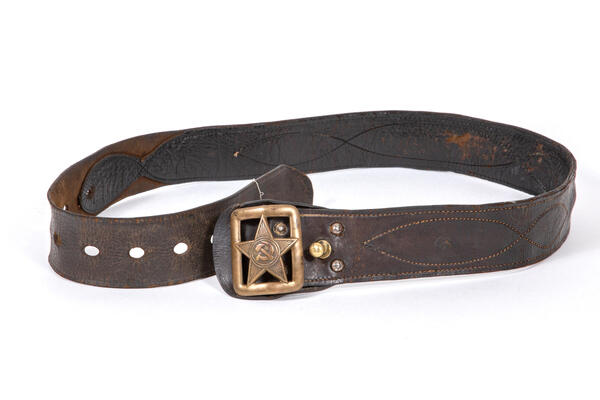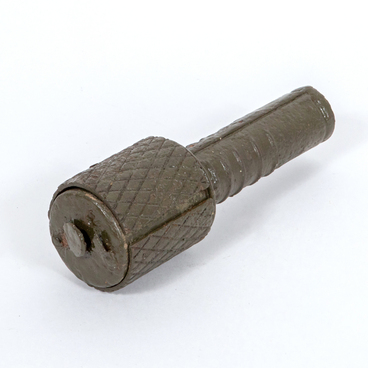The officer’s belt, displayed in the collection, is made of two layers of dark brown leather with a thickness of four millimeters each. They are glued and sewn with silk threads along the edges. In the middle of the belt is a stitched pattern — it was made to ensure greater durability and to differ from soldiers' belts.
The belt buckle has no pins. It consists of a slightly curved outwards frame and a stamped five-pointed star (5 cm in length) with clear relief images. In the round medallion of the star, bordered by two rims, the hammer and sickle are pressed against the background of rays emerging from the center. The rays of the inner circle continue at the ends of the star. The star is firmly brazed to the frame.
Until the early 1930s, Red Army commanders often had to wear the old ‘Mikulin’ double-shoulder accoutrements of the 1912 model. It included a brown belt with a metal buckle and brass half-rings attached to the shoulder straps. On the back, they either crossed over or were connected by a diamond-shaped ring. A case for the commander’s whistle was hung on the left shoulder strap; while a holster, a canteen, and a small bag were attached to the belt.
In September 1923, the order No.936 of the Revolutionary Military Council of the USSR approved the equipment of the commanding staff of the Red Army infantry. It included a basic single pin brown leather belt with a width of 45 millimeters and a brass buckle. Later, they developed and introduced new hiking equipment and everyday uniforms for middle-level, senior and commanding officers of the army and air force. It included a 50 mm belt with a double pin metal buckle.
The buckle from the collection of the Noyabrsk Museum had no pins and was approved by the order of the People’s Commissar of Defense in December 1935. It was part of the uniform of the leading and commanding staff of the Red Army in 1935-1941. At the beginning of the Great Patriotic War, the style of the uniform and the way it was worn were determined by this order. These approved accoutrements with insignificant changes were used in the Soviet Army up until the collapse of the USSR.
The belt buckle has no pins. It consists of a slightly curved outwards frame and a stamped five-pointed star (5 cm in length) with clear relief images. In the round medallion of the star, bordered by two rims, the hammer and sickle are pressed against the background of rays emerging from the center. The rays of the inner circle continue at the ends of the star. The star is firmly brazed to the frame.
Until the early 1930s, Red Army commanders often had to wear the old ‘Mikulin’ double-shoulder accoutrements of the 1912 model. It included a brown belt with a metal buckle and brass half-rings attached to the shoulder straps. On the back, they either crossed over or were connected by a diamond-shaped ring. A case for the commander’s whistle was hung on the left shoulder strap; while a holster, a canteen, and a small bag were attached to the belt.
In September 1923, the order No.936 of the Revolutionary Military Council of the USSR approved the equipment of the commanding staff of the Red Army infantry. It included a basic single pin brown leather belt with a width of 45 millimeters and a brass buckle. Later, they developed and introduced new hiking equipment and everyday uniforms for middle-level, senior and commanding officers of the army and air force. It included a 50 mm belt with a double pin metal buckle.
The buckle from the collection of the Noyabrsk Museum had no pins and was approved by the order of the People’s Commissar of Defense in December 1935. It was part of the uniform of the leading and commanding staff of the Red Army in 1935-1941. At the beginning of the Great Patriotic War, the style of the uniform and the way it was worn were determined by this order. These approved accoutrements with insignificant changes were used in the Soviet Army up until the collapse of the USSR.



